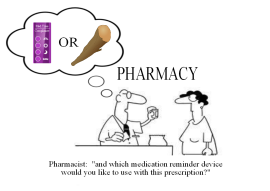Remember the Reminders… the medication reminders, that is.
Considering the scope of the medication adherence and compliance problem in the U.S. it just makes good sense to use any means possible to help patients improve their compliance with prescription drug therapy. If you’ve read any of my recent blog posts or follow healthcare news at all you’re well aware of the extent of the problem, the cost of which is now reported to be over $300 billion annually in the U.S. alone.
of the problem, the cost of which is now reported to be over $300 billion annually in the U.S. alone.
I’m now seeing other effects of non-compliance with information suggesting the medication compliance problem may be putting the public at even greater risk. There is evidence showing over 50% of drug clinical trial patients do not report missed doses to the clinical trial study team. This could result in problems experienced later by the public after the FDA has approved the sale of new drug products in the market place.
Finding the right fit –
So how do medication reminders fit into the scheme of things and what reminder tools or devices should be used?
There are many medication reminder tools and devices available ranging from simple pill boxes or organizers and reminder caps on pill bottles to smart phone apps and automated pill dispensers. The choice of medication reminder tools or devices would also depend on the needs of the patient with special considerations given for high risk patients who may be living in environments with little or no supervision by family or outside healthcare services.
Direct or indirect patient contact through text messages, email or telephonic messages will also influence patient compliance. But even with the plethora of medication reminder devices and techniques available we cannot discount the influence of direct patient education and encouragement from healthcare professionals.
Patient education coupled with the right reminder tools or device will produce the greatest dividends towards combating the medication adherence and compliance problem that exists today.
Improving patient outcomes – saving healthcare dollars –
Here are a few examples where medication compliance reminder tools or devices can be easily inserted into the healthcare delivery process:
- reminder devices provided through hospital discharge planning and follow up of high risk patients to prevent re-admissions
- reminder devices provided during counseling sessions by pharmacists, home health or home care agencies
- reminder devices provided before leaving the physician’s office with a new prescription for maintenance medications
- reminder devices provided in conjuction with special clinical monitoring including anti-coagulation clinic therapy or other similar outpatient services
- reminder devices provided by pharmaceutical companies marketing products and drug therapies to improve product recognition, acceptance and compliance
- reminder devices provided as an adjunct to monitoring patients participating in clinical trials
- reminder devices provided by insurance, 3rd party payers or self insured businesses to reduce expenses related to medication non-compliance in patients taking maintenance medications
- reminder devices provided to residents of independent living or retirement communities
A liberal dose of medication reminders –
For the most part we can’t control a patient’s healthcare decisions. We can’t make people take their medications if they’ve decided not to. We can, however, help steer them in the right direction with proper education and encouragement. Adding a liberal dose of medication reminder devices to the patient’s drug therapy regimen along with patient education has the greatest chance of improving compliance with prescription medication therapy.
Put on your thinking caps –
I challenge you to think of other ways to incorporate medication reminder devices into the healthcare delivery process. I look forward to your thoughts and ideas and encourage you to comment or contact me directly via email at dave.walker@medtime-compliance.com

